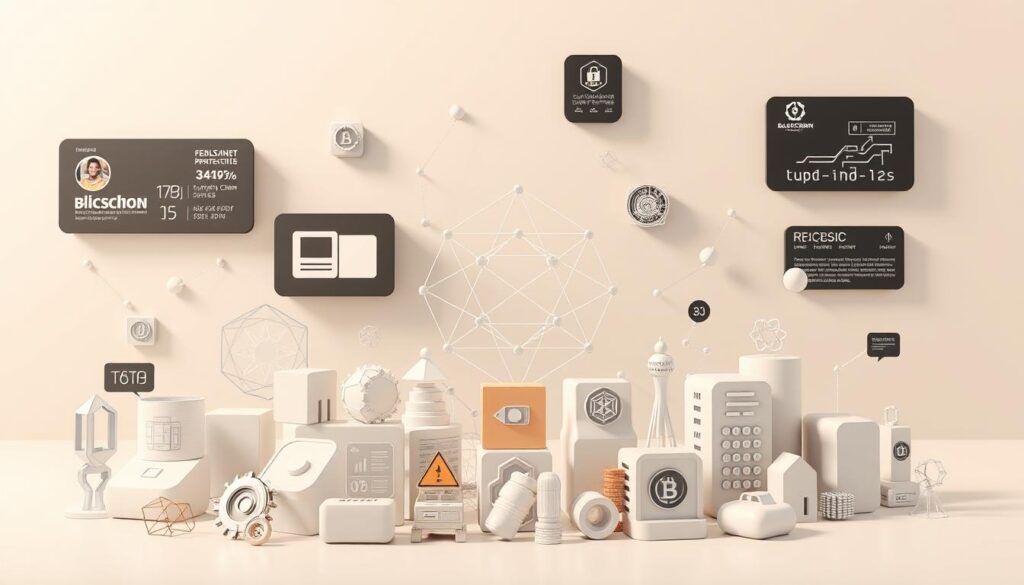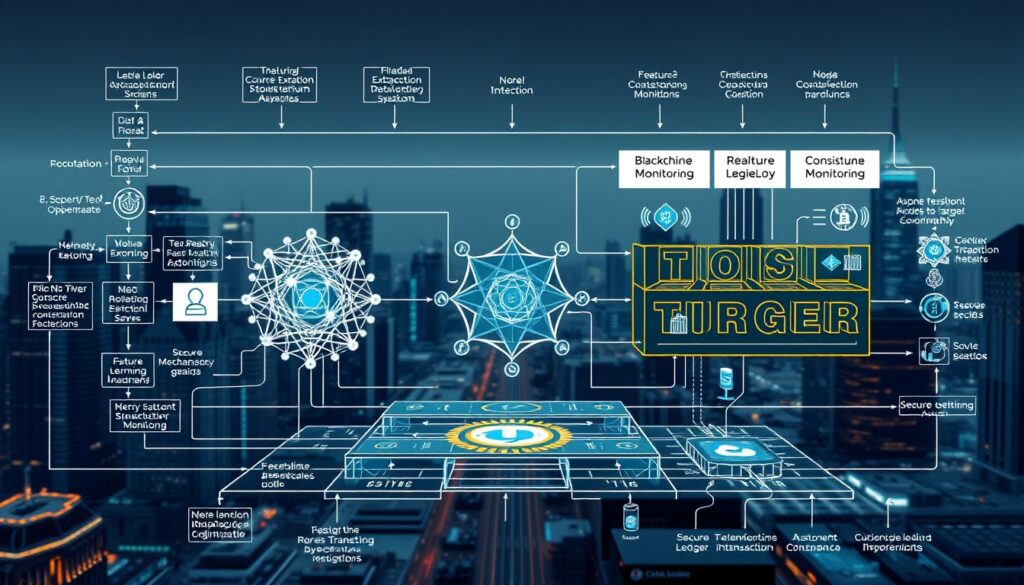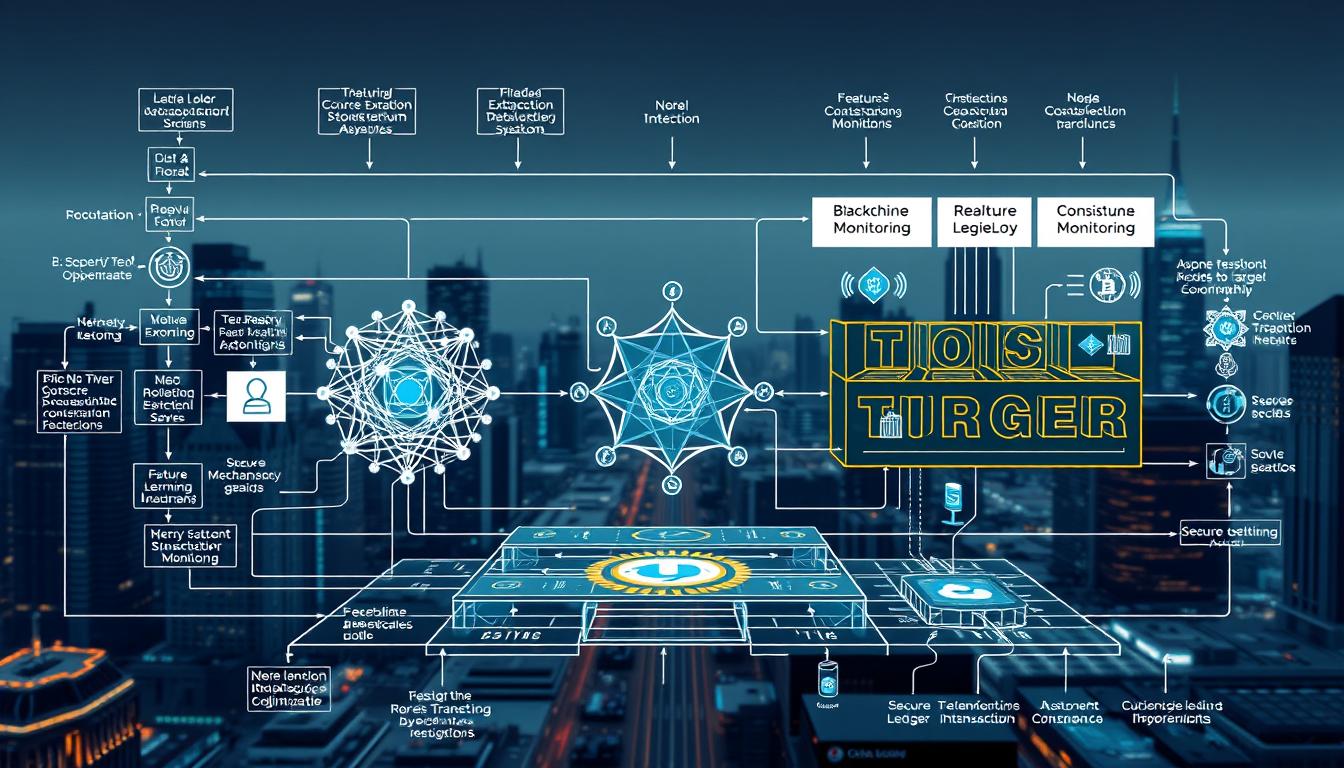Now Reading: Understanding Blockchain Data Storage Immutable Records
- 01
Understanding Blockchain Data Storage Immutable Records
Understanding Blockchain Data Storage Immutable Records

Modern businesses face growing challenges with information management. Traditional methods often struggle with security and transparency. This creates a need for more reliable systems.
The global market for this innovative technology is expanding rapidly. Projections show growth from $17.57 billion in 2023 to over $825 billion by 2032. This explosive expansion demonstrates increasing organizational confidence.
Immutability serves as the cornerstone feature that builds trust. Once information enters the system, it cannot be altered or deleted. This permanent nature eliminates the need for intermediaries in transaction processing.
Research from Deloitte reveals that 81% of executives believe this technology has reached mainstream adoption. They cite transparency and the unchangeable nature as key drivers. These characteristics establish strong credibility for the entire system.
Key Takeaways
- Blockchain technology creates permanent, unchangeable records that enhance trust
- The global market is projected to grow exponentially through 2032
- Immutability prevents data tampering and eliminates intermediary needs
- Most executives recognize this technology as mainstream due to its transparency
- This approach addresses critical challenges in traditional information management
- Organizations benefit from improved security and regulatory compliance
- The system provides a decentralized method for managing sensitive information
Introduction to Blockchain and Immutable Data
The digital age necessitates reliable methods for preserving important documentation. Traditional systems often lack the robustness needed for today’s security demands.
Defining Blockchain Technology
This innovative approach functions as a decentralized digital ledger. It securely maintains records across multiple computers simultaneously.
Each unit in the system contains specific information. These units connect chronologically, forming a continuous sequence. The structure ensures transparency and resistance to alteration.
The concept originated with Bitcoin’s creation in 2008. Satoshi Nakamoto designed it for peer-to-peer exchanges without middlemen. This foundation revolutionized how digital transactions occur.
The Importance of Immutability
Permanence represents the system’s most valuable characteristic. Once information enters the ledger, it becomes unchangeable. This creates inherent trust among participants.
Users can rely on the accuracy of records without third-party verification. The technology’s applications extend far beyond cryptocurrency uses.
| Feature | Traditional Systems | Blockchain Approach |
|---|---|---|
| Data Integrity | Centralized control | Distributed verification |
| Record Alteration | Possible with access | Cryptographically prevented |
| Trust Mechanism | Requires intermediaries | Built into system design |
| Network Structure | Single point of failure | Resilient across network |
Various industries benefit from these permanent recording capabilities. The technology continues evolving to meet diverse organizational needs.
Blockchain Data Storage Immutable Records
A new era of trustworthy record-keeping emerges through cryptographic security methods. This approach ensures information remains permanently accessible and verifiable.
The system functions as an append-only digital ledger. Once entries are added, they cannot be modified or deleted. This creates a continuous chain of verified information.

Each unit contains timestamped details and cryptographic hashes. These elements connect chronologically, forming a secure sequence. The structure prevents unauthorized changes through advanced encryption.
This permanent nature establishes unprecedented reliability across various sectors. From financial services to supply chain management, organizations benefit from tamper-proof documentation. The technology represents a significant shift from traditional mutable databases.
| Aspect | Traditional Systems | Blockchain Approach |
|---|---|---|
| Modification Capability | Editable by authorized users | Permanently fixed once added |
| Verification Process | Centralized authority required | Distributed network consensus |
| Historical Accuracy | Potential for revision | Complete preservation |
| Security Foundation | Access controls | Cryptographic protection |
The immutable characteristic ensures consistent and reliable record transactions across applications. This framework eliminates single points of failure while maintaining complete transparency. As blockchain technology continues evolving, its impact on secure information management grows increasingly significant.
How Blockchain Ensures Data Integrity
Digital trustworthiness relies on sophisticated security protocols that prevent unauthorized changes. These systems maintain information accuracy through advanced mathematical processes.
Cryptographic Hashing Explained
Each unit in the system receives a unique digital fingerprint called a hash. This hashing process uses complex algorithms to create distinctive identifiers.
The hash value changes completely if any detail within the block is altered. This makes tampering immediately detectable across the entire network.
Consensus Mechanisms (PoW & PoS)
Network participants agree on transaction validity through consensus protocols. Proof of Work requires miners to solve complex mathematical problems.
Proof of Stake randomly selects validators based on their cryptocurrency holdings. Both methods ensure information added to the system is verified by multiple parties.
This combination of hashing and consensus creates security layers that make alterations nearly impossible. The interconnected nature of blocks means changing one requires modifying all subsequent units.
The Process Behind Immutable Record-Keeping
Digital permanence is achieved through carefully structured recording methods. This systematic approach ensures information remains unchanged once entered into the ledger.

Block Formation and Linking
Each transaction becomes a digital block containing comprehensive details. These blocks capture participant information, amounts, timestamps, and specific conditions.
The formation process involves collecting and validating transaction information across the network. Once verified, this information packages into a new block with a unique cryptographic identifier.
Each unit connects to previous and subsequent blocks through cryptographic hashes. This creates an unbreakable chain where altering one block would require changing all following units.
Role of Decentralization
Distributed architecture plays a crucial role in maintaining system integrity. Instead of central servers, information spreads across numerous network participants.
Every node maintains a complete copy of the entire chain. This redundancy prevents any single entity from controlling or corrupting the information.
| Characteristic | Centralized System | Decentralized Ledger |
|---|---|---|
| Control Structure | Single authority | Distributed consensus |
| Failure Points | Single server vulnerability | Network-wide resilience |
| Update Process | Central administrator | Network agreement required |
| Data Access | Limited locations | Available across all nodes |
The combination of cryptographic linking and distributed architecture creates a self-reinforcing system. This dual protection makes the ledger exceptionally reliable for permanent record-keeping.
Leveraging Smart Contracts for Secure Transactions
Self-executing digital agreements represent the next evolution in secure automation. These innovative tools transform how organizations handle contractual obligations.

Smart contracts function as automated agreements with terms encoded directly into computer programs. When predetermined conditions are met, these contracts execute automatically without human intervention.
Automated Execution of Agreements
The true power of these digital contracts lies in their autonomous operation. They eliminate intermediaries by handling transactions directly between parties.
Processing times shrink from days to minutes through this automation. Businesses benefit from accelerated operations and reduced administrative costs.
Ethereum’s 2015 introduction marked a significant milestone for programmable agreements. This platform enabled complex contracts beyond simple currency exchanges.
Users gain confidence knowing terms execute exactly as programmed. The system’s design prevents alterations after deployment, ensuring reliable performance for all transactions.
Applications and Use Cases of Immutable Blockchain Records
From food safety to financial services, permanent digital ledgers are revolutionizing business processes. These practical implementations demonstrate real-world value across multiple sectors.

Supply Chain Management
The IBM Food Trust system provides an excellent example of supply chain innovation. This approach tracks food products from origin to delivery.
Companies like Walmart use this technology to identify contamination sources quickly. Traditional methods might take weeks, but this system works in hours.
Home Depot also implements similar solutions for vendor disputes. The benefits include improved efficiency and fraud prevention throughout the supply chain.
Financial Services and Healthcare
Financial institutions process transactions in minutes instead of days. This speed advantage operates regardless of holidays or time zones.
Healthcare providers secure patient information using cryptographic methods. Patients control access through private keys while maintaining privacy.
Property ownership timelines become transparent and verifiable. These use cases build trust while eliminating traditional inefficiencies.
Overcoming Challenges in Implementing Immutable Blockchain Solutions
While blockchain’s unchangeable nature offers clear security advantages, organizations encounter specific implementation hurdles. These complications require strategic approaches to maintain both functionality and compliance.
Error Correction and Legal Implications
The permanent nature of this technology creates difficulties when mistakes occur. Human errors become fixed in the ledger, making corrections nearly impossible without complex solutions.
Legal requirements like GDPR’s “right to be forgotten” conflict directly with the system’s design. Organizations face compliance issues when personal information must remain permanently accessible.
These challenges test the balance between security and practical business needs. Companies must develop workarounds that respect both technological constraints and regulatory demands.
Scalability and Network Forks
As participation grows, blockchain networks experience congestion and performance limitations. Maintaining consensus across thousands of nodes becomes increasingly difficult.
Network forks present another significant challenge. Both hard and soft forks can create divergent chains, complicating the consistency of transaction records.
Security threats like the 51% attack remain theoretical concerns. While fraud through transaction reversal is possible in theory, established networks make this extremely difficult to execute.
Emerging technologies like quantum computing pose future risks to cryptographic protection. Additionally, energy-intensive consensus mechanisms raise environmental concerns that impact public trust in these systems.
Blockchain versus Traditional Data Storage Methods
Information management approaches have fundamentally diverged between centralized and decentralized models. These architectural differences create distinct advantages for specific business applications.
Enhanced Security and Trust
Traditional systems concentrate information in single locations, creating vulnerable points. This centralized design requires trust in administrators who can modify or delete entries.
Distributed ledger technology spreads information across network participants. Tampering becomes nearly impossible without controlling most nodes.
Transaction processing shows dramatic time differences. Centralized systems operating during business hours can take days for settlement. The decentralized approach runs continuously, completing transactions in minutes.
Transparency benefits authorized users through complete visibility into histories. This contrasts with traditional systems that often obscure access logs.
Cost efficiency improves by eliminating third-party verification requirements. Businesses reduce operational expenses while maintaining higher security standards against fraud.
Integrating Emerging Technologies with Blockchain
Forward-thinking enterprises are discovering powerful advantages by merging decentralized ledgers with artificial intelligence and connected devices. This integration creates synergistic effects that enhance operational capabilities across multiple sectors.
The combination of distributed verification systems with AI algorithms addresses critical challenges in modern business operations. AI systems gain access to verified, tamper-proof training information through this approach.
AI and IoT Synergies
In supply chain management, distributed ledgers ensure product authenticity while AI analyzes trusted information to predict demand patterns. This dual approach optimizes logistics and reduces operational costs significantly.
Financial services benefit from automated risk assessments powered by AI using secured transaction records. The distributed network ensures compliance through verifiable audit trails that regulators can trust.
Healthcare applications demonstrate the powerful role of this integration. AI analyzes patient information for personalized treatments while the underlying system ensures privacy and security. Patients maintain control over their medical records.
Internet of Things devices generate massive amounts of information that require secure verification. Distributed networks provide the necessary infrastructure to track device communications and prevent unauthorized modifications.
These technological convergences enhance trust among business partners and users. They boost efficiency through automation and support faster, more reliable processes across various systems.
Future Trends and Best Practices in Blockchain Development
The evolution of distributed ledger technology continues to address critical challenges while opening new possibilities. Emerging innovations focus on enhancing efficiency, security, and sustainability across various applications.
These advancements aim to balance technological progress with practical business needs. They represent the next phase of maturity for this transformative approach.
Sustainable Consensus Mechanisms
Energy-efficient validation methods are gaining prominence as alternatives to traditional approaches. Proof-of-Stake and delegated Proof-of-Stake significantly reduce environmental impact while maintaining security.
These mechanisms validate transactions without intensive computational work. They enable broader participation while conserving resources.
The shift toward greener operations includes renewable energy adoption for network operations. Carbon offset programs and certifications help mitigate ecological concerns.
Quantum-Resistant Cryptography
Future-proof security measures are essential as computing power advances. Quantum-resistant algorithms protect against emerging threats that could compromise current encryption.
Researchers are developing cryptographic solutions based on quantum principles. These approaches safeguard historical information from potential future attacks.
Implementation requires careful planning and gradual integration. The goal is maintaining trust while preparing for technological evolution.
Scalability solutions like sharding and layer-2 protocols enable networks to handle increased transaction volumes. These improvements support growing user bases without sacrificing reliability.
Governance models continue evolving to ensure efficient protocol upgrades. Participatory decision-making maintains consensus while allowing necessary improvements.
Conclusion
As organizations increasingly rely on digital verification, the unchangeable quality of distributed ledgers becomes essential. This technology’s permanent nature creates unprecedented trust across financial, healthcare, and supply chain applications.
While challenges around error correction and privacy persist, ongoing innovations provide practical solutions. Quantum-resistant cryptography and sustainable algorithms address both security and environmental concerns.
The fundamental benefits of immutable ledger technology ensure its continued evolution toward mainstream adoption. These systems offer transparent, accountable frameworks for critical information management.
This approach represents more than technical advancement—it establishes new standards for digital trust. As technology progresses, these permanent recording methods will underpin our increasingly interconnected world.
FAQ
What makes a record on a blockchain nearly impossible to change?
The security comes from a combination of cryptographic hashing and decentralization. Each block contains a unique digital fingerprint (hash) of its data and the hash of the previous block. This creates a chain. Altering any information would change its hash, breaking the link and requiring recalculation of all subsequent blocks across the entire network, which is computationally infeasible.
Can smart contracts be used outside of cryptocurrency?
Absolutely. These self-executing contracts have broad applications. In supply chain management, they can automatically release payments upon delivery confirmation. In healthcare, they can manage patient consent for data sharing. Their automated execution ensures agreements are carried out precisely as coded, reducing delays and potential for fraud.
How does a blockchain network achieve consensus without a central authority?
Networks use consensus mechanisms like Proof of Work (PoW) or Proof of Stake (PoS). These protocols require participants (nodes) to agree on the validity of a transaction before it’s added to the ledger. This decentralized verification process replaces the need for a single trusted intermediary, building trust among users.
What happens if incorrect information is accidentally added to the ledger?
This is a key challenge. Due to its immutability, data cannot be erased. The standard practice is to add a new, corrective transaction that effectively nullifies the error. This creates a transparent audit trail of the mistake and its correction, which can be important for legal implications and maintaining an accurate history.
How does blockchain technology improve transparency in systems like supply chains?
It provides a single, shared source of truth. Every step—from raw material sourcing to final delivery—can be recorded as a transaction on the ledger. All authorized participants can view this unchangeable history, which greatly enhances transparency, helps verify authenticity, and quickly pinpoint inefficiencies or sources of problems.
Are traditional databases becoming obsolete because of this technology?
Not at all. Traditional databases excel at speed and handling vast amounts of private data. This technology is superior for creating tamper-proof records where trust and verification among multiple parties are critical. The two systems often serve different purposes and can even be integrated for optimal results.
















